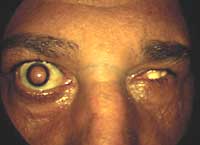
This is a rare disease affecting the eyes, though it can have a profound impact.
Essentially it is inflammation of both eyes, following trauma to one eye. It can leave the patient completely blind. Symptoms may develop from days to several years after someone has suffered a penetrating eye injury. However 80% of ‘victims’ will suffer the condition within 3 months. There are not thought to be gender, racial or any other factors that might lead to an increased risk of the disease.
Presentation
Diagnosis is reached by assessing the clinical findings following an examination- there are no simple laboratory tests to confirm the diagnosis.
The floaters in the eyes and difficulty in adjusting vision to near or far objects are the earliest symptoms to be described and may progress to a painful eye (uveitis) and any discomfort when looking at lights (photophobia) at a later stage when the diagnosis is most often made.
There is often a history of blurry, distorted vision and photophobia in the normal eye (or sympathetic eye, hence the name of this condition), as previously all these features can develop gradually. The eye which had the injury/illness is known as the ‘exciting eye’. Both eyes can develop any or all of these features.
The eye may also be reddened due to inflammation.
Pathology
As stated above, this disease is due to an inflammatory process, and there is a localized response giving rise to nodules on the back of the eye as well as the lining of the eye. This inflammation is due to the body reacting to itself, with the reaction being a delayed hypersensitivity reaction to the choroid layer of the eye (the eye is like an onion having layers of tissues including that which contains the seeing cells, cones and rods – this layer is not often involved albeit that the retinal blood vessels may be affected). This is because those antigens are not exposed ordinarily to the body’s immune system.
Treatment
The initial treatment regime is with oral steroids; if there is not an adequate response then other immunotherapy agents such as cyclosporine or azathioprine can be given.
Possible different diagnoses
Tuberculosis, syphilis and sarcoidosis are the differential diagnoses although having both eyes involved at the same time does not frequently occur in these three conditions.
Also in the back of the clinician’s mind should be the diagnosis of either a fungal or bacterial infection, either of which may be devastating to the patient’s sight if untreated. Again, both eyes are not often involved in these infections.
A high degree of suspicion must be maintained and treatment started as soon as possible so as to avoid the listed complications.
MEDICOLEGAL ASPECTS
It is crucial to explain the warning signs as mentioned above to the patient and that the patient knows where he/she can get help after an injury or illness to his/her eyes. This conversation should be written clearly in the notes. Prior to any operative procedure, the consent ideally should have mentioned this complication, sympathetic ophthalmia.
The impact on daily activities from this condition may be enormous, e.g. limiting the ability of being able to drive. Other complex tasks similarly may be affected, hindering the patient being able to live a normal life.
If you want further information about this particular topic, or wish to discuss the possibility of bringing a claim for Clinical Negligence - or indeed any other type of injury, please contact the Dutton Gregory Clinical Negligence Team on (01202) 315005, or email k.marden@duttongregory.co.uk
NB This article does not constitute legal advice and should not be relied on as such. No responsibility for the accuracy and/or correctness of the information and commentary set out in the article, or for any consequences of relying on it, is assumed or accepted by any member of Dutton Gregory LLP.






